
Dig Dug is a maze arcade video game released by Namco in 1982. It was distributed in North America by Atari, Inc. The player digs underground tunnels to attack enemies in each level, by either inflating them to bursting or crushing them underneath rocks.
1988 saw many sequels and prequels in video games, such as Dragon Quest III, Super Contra, Super Mario Bros. 2, Mega Man 2, Double Dragon II: The Revenge, and Super Mario Bros. 3, along with new titles such as Assault, Altered Beast, Capcom Bowling, Ninja Gaiden, RoboCop, Winning Run and Chase H.Q.
1987 saw many sequels and prequels in video games, such as Castlevania II: Simon's Quest, Dragon Quest II, Final Lap, and Zelda II, along with new titles such as After Burner, Contra, Double Dragon, Final Fantasy, Mega Man, Metal Gear, Operation Wolf, Phantasy Star, Shinobi, Street Fighter and The Last Ninja. The Legend of Zelda was also introduced outside of Japan.
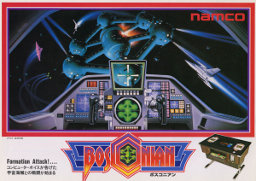
Bosconian is a scrolling multidirectional shooter arcade video game developed and released by Namco in Japan in 1981. In North America, it was manufactured and distributed by Midway Games. The goal is to earn as many points as possible by destroying enemy missiles and bases using a ship which shoots simultaneously both the front and back.

Rally-X is a maze chase arcade video game developed in Japan and Germany by Namco and released in 1980. In North America, it was distributed by Midway Manufacturing and in Europe by Karateco. Players drive a blue Formula One race car through a multidirectional scrolling maze to collect yellow flags. Boulders block some paths and must be avoided. Red enemy cars pursue the player in an attempt to collide with them. Red cars can be temporarily stunned by laying down smoke screens at the cost of fuel. Rally-X is one of the first games with bonus stages and continuously-playing background music.
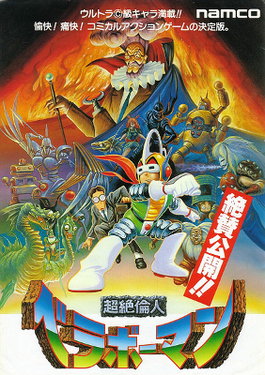
Chōzetsurin Jin Bravoman is a 1988 beat'em up arcade video game developed and published in Japan by Namco. Described as a "comical action game", the player controls the titular character, a bionic superhero with telescopic limbs, as he must defeat the villainous Dr. Bomb before he takes over the world. Bravoman can use his arms, legs and head to defeat enemies, and can also crouch and jump over them. The game ran on the Namco System 1 arcade board.

Dig Dug II is an action arcade video game developed and published in Japan by Namco in 1985. It is a sequel to 1982's Dig Dug. Pookas and fire-breathing Fygars return as the enemies, but the side view tunneling of the original is replaced with an overhead view of an island maze.

Galaga '88 is a 1987 fixed shooter arcade video game developed and published in Japan by Namco and in North America and Europe by Atari Games. It is the third sequel to Galaxian. It features significantly improved graphics over the previous games in the series, including detailed backgrounds, larger enemies and greater ship details. The game runs on Namco System 1 hardware.
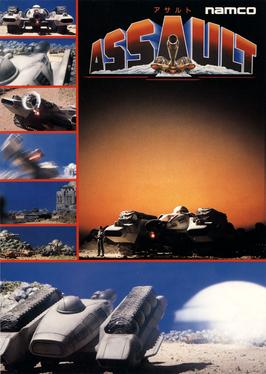
Assault is a 1988 multi-directional shooter arcade game developed and published by Namco. It was licensed to Atari Games for release in North America. Controlling a caterpillar-tread self-propelled gun, the player is tasked with completing each of the game's eleven stages while shooting enemies and avoiding projectiles. It uses a twin-stick control layout, similar to games such as Battlezone. The plot involves the human race searching for new planets after Earth reaches its maximum population - after discovering an exo-planet 35,000 light years away from the Milky Way, they enslave the planet's natives and take control, leading to the planet's native population vowing to abolish the humans and bring peace to their world. The protagonist who rides the aforementioned self-propelled gun which players control, is one such native.

Dragon Spirit is a 1987 vertical-scrolling shooter arcade game developed and published by Namco. In North America, it was distributed by Atari Games. Controlling the dragon Amur, the player must complete each of the game's nine areas to rescue the princess Alicia from the demon Zawell. Similar to Namco's own Xevious, Amur has a projectile weapon for destroying air-based enemies and a bomb for destroying ground enemies. It ran on the Namco System 1 arcade board.

Genpei Tōma Den is a side-scrolling hack and slash video game produced by Namco that was released as a coin-operated video game in 1986 in Japan. It runs on Namco System 86 hardware. Over a decade later, the game was released in America and Europe in the video game compilation Namco Museum Vol. 4 under the title of The Genji and the Heike Clans for the PlayStation.
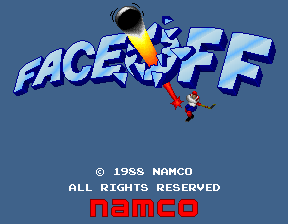
Face Off is an ice hockey arcade game developed and released by Namco for Japan only in 1988. Up to four players control players from one of eight hockey teams against each other, the objective being to score the most points before the timer ends. Similar to Namco's own Final Lap, multiple cabinets can be linked together to enable multiplayer play. It runs on the Namco System 1 arcade board. Face Off received a favorable critical reception for its visuals and gameplay. A digital re-release for the Wii Virtual Console was released in Japan in 2009.
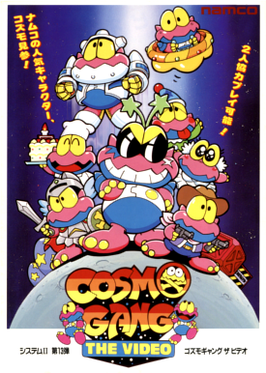
Cosmo Gang the Video is a 1992 fixed shooter arcade game developed and published by Namco. A home conversion for the Super Famicom was released the same year. Controlling the Hyper Beat starship, the player is tasked with ridding the galaxy of the Cosmo Gang, a race of aliens that cause mischief across Earth. Gameplay involves shooting enemies and avoiding projectiles. Power-up items can be collected to grant the player additional abilities. It ran on the Namco System 2 arcade board.
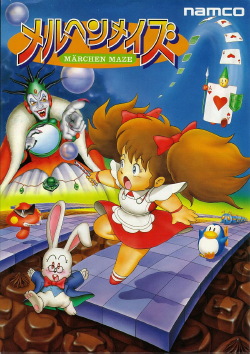
Märchen Maze is a 1988 isometric platform arcade game developed by N.H. System and published by Namco. Controlling a young girl named Alice, the player must complete each of the game's nine stages while avoiding enemies and falling off ledges. Alice can blow powerful bubbles at enemies to knock them back, and can hit them enough times to send them off the platform. It is the first Japanese video game adaptation of Lewis Carroll's Alice's Adventures in Wonderland, and runs on the Namco System 1 arcade board.
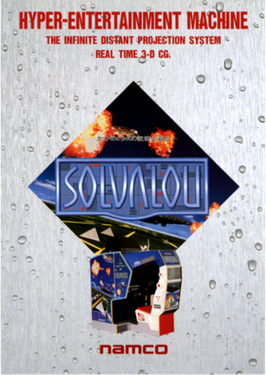
Solvalou is a 1991 first-person rail shooter arcade game developed and published in Japan by Namco. The sixth entry in the Xevious series, the player takes control of the Solvalou starship from a first-person perspective as it must destroy the Xevious forces before they take control of Earth. The Solvalou has two weapon types: an air zapper to destroy air-based enemies, and a blaster bomb to destroy ground-stationed enemies. It runs on the Namco System 21 arcade board.
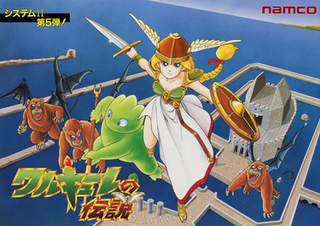
Valkyrie no Densetsu is a 1989 action-adventure role-playing arcade game developed and published in Japan by Namco. It is a follow-up to the Family Computer game Valkyrie no Bōken (1986). Players control the warrior maiden Valkyrie and her lizard-like companion Kurino Xandra as they set out to drop a mythical item called the Golden Seed into the Northern Fountain to replenish the dying crop fields of Xandra Land. Gameplay involves defeating enemies and collecting gold to purchase magical spells and weapons in shops.

Kyūkai Dōchūki is a baseball arcade game that was released by Namco in 1990 in Japan; it runs on Namco System 2 hardware, and is a spin-off of Yokai Dochuki. The gameplay is similar to that for Namco's own World Stadium series, except that both players have a total of thirty-six different teams to choose from in the Japanese, Arabic, German, Humbaba, American, Russian, and Chinese leagues. The Japan League has five stadiums, and if the first player selects one team from it, it will randomly decide which one the match will take place in, but the other leagues only have one stadium. This game also features a cameo re-appearance, from Valkyrie, who appears to report the final outcome of a match once it has finished, and Namco's signature character Pac-Man can also be seen on two of the television screens in her studio wearing a purple bow tie.
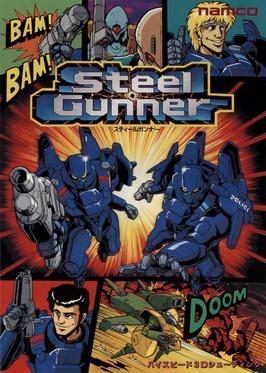
Steel Gunner is a 1990 first-person shooter arcade game developed and published by Namco. Players take control of Garcia and Cliff, a duo of police officers that are part of the Neo Arc police force, as they must use their powerful Gargoyle mecha suits to destroy the STURM terrorist organization, who have taken captive scientists Dr. Ryan and Dr. Ellis to create a world-ending superweapon. Gameplay revolves around using a crosshair to shoot down enemies and avoid harming civilians. It runs on the Namco System 2 Plus arcade hardware.

Cosmo Gang the Puzzle is a 1992 falling block puzzle arcade video game developed and published by Namco worldwide. The third game in its Cosmo Gang series, succeeding that year's Cosmo Gang the Video, players stack groups of blocks and aliens known as Jammers in a vertical-oriented well. The objective is to clear as many objects on the screen before they reach the top of the screen. Blocks are cleared by aligning them into complete horizontal rows, while Jammers are cleared by defeating them with blue-colored spheres.

Pro Baseball: Family Stadium, released as Pro Yakyū: Family Stadium in Japan and R.B.I. Baseball in North America, is a 1986 baseball video game developed and published by Namco for the Family Computer. In North America, it was published by Tengen as R.B.I. Baseball for the Nintendo Entertainment System. It was also released in arcades through the Nintendo VS. System. It is the first game in the Family Stadium and R.B.I. Baseball franchises. The game was a critical and commercial success in Japan and North America.



















